Abstract
The present study analyzed the impact of the running style and the morphologic and functional characteristics of the foot on the incidence of non-traumatic foot and lower limb disorders in runners. From January 2004 to December 2008, we prospectively examined 166 runners, both recreational and competitive, involved in various running specialities, from three athletics clubs in Northern Italy. They were 86 males and 80 females, with a mean age of 31.1 ± 12.2 years. We considered non-traumatic foot and lower limb diseases reported during the follow-up period, which resulted in a minimum sport rest of two weeks. The incidence of these diseases was examined with respect to general characteristics, type of activity, foot morphology, running style. 59% of athletes reported one or more diseases. The most common were plantar fasciitis (31% of athletes) and Achilles tendinopathies (24%). Overall, the more prone to injuries were males (60.9% of cases), competitive runners (70.9%), middle-distance runners (51.7%), and those using spike shoes (80.3%). Age, body weight and height were not important predictors of running injuries in general. Considering the morphological characteristics of the foot, the most prone to injury were the varus hindfoot (87.5% of cases) and the cavus arch (71.4%). In conclusion, a deep knowledge of the factors predisposing runners to specific diseases, often chronic and highly debilitating for the athlete, may allow implementing effective therapeutic measures.
Key points.
Examination of 166 runners during a period of five years of activity.
The incidence of these diseases was examined with respect to general characteristics, type of activity, foot morphology, running style.
59% of athletes reported one or more diseases. The most common were plantar fascitis (31% of athletes) and Achilles tendinopathies (24%).
Overall, the more prone to injuries were males (60.9% of cases), competitive runners (70.9%), middle-distance runners (51.7%), and those using spike shoes (80.3%).
Age, body weight and height were not important predictors of running injuries in general.
The most prone to injury were the varus hindfoot (87.5% of cases) and the cavus arch (71.4%).
Key words: Running, foot, disease.
Introduction
Running has always been an integral part of human life. In recent years running has become increasingly popular as a recreational and competitive activity. Running also constitutes the fundamental action of the majority of individual and team sports. The ground reaction force at the time of the midstance phase in running ranges from 1.5 to 5 times body weight (Birrer et al., 2001; Cavanagh et al., 1980); at a pace of seven minutes per mile, running implies approximately 5,000 contacts per hour of running; considering those huge loads on the tissues it is clear that even small abnormalities can result in a significant load concentration on the foot. Running foot diseases are in large part non-traumatic, being mostly related to overuse. Many studies documented a great incidence of running related foot disorders, with an overall yearly incidence of 37-56% (Bovens et al., 1989; Jacobs et al., 1986; Pollock et al., 1977; Watson et al., 1987).
A lot of variables may predispose to the various foot diseases: such variables can be divided into extrinsic and intrinsic. Extrinsic factors are present in 60-80% of reported injuries (James et al., 1978; McKenzie et al., 1985), and include type and level of activity, training errors, running surfaces and footwear. Intrinsic factors include age, gender, height, weight, foot or leg abnormalities, muscle imbalance, inadequate strength or flexibility, poor neuro-muscular coordination, ligament laxity.
All these variables can affect the incidence of foot diseases, but yet the literature is far from having examined the actual impact of the single factors. For this reason we undertook an epidemiological study on a large population of runners, recreational and competitive, from various specialties. Each was examined through an evaluation form assessing the personal data, type of activity, running style and the morphologic and functional characteristics of the foot. The incidence of each parameter was statistically evaluated in relation to non-traumatic disorders of the foot and lower limb, reported during a follow-up period of five years.
Methods
From January 2004 to December 2008, we examined 166 runners, at both a recreational and competitive level, involved in various running specialities, from three athletics clubs in North Italy. They were 86 males and 80 females, with a mean age of 31.1 ± 12.2 years at the time of the first examination.
We considered non-traumatic foot and lower limb diseases resulting in a minimum rest period of two weeks. Foot diseases were divided into muscular (injuries of the knee flexors or triceps surae, chronic compartment syndrome of the anterior compartment of the leg), tendinous (plantar fasciitis, Achilles tendinopathy), bony (stress fractures, metatarsalgia).
At the fist evaluation each athlete was examined with the evaluation form represented in Table 1, including general characteristics, type of activity, foot morphology, running style.
Table 1.
Evaluation form.
| Generalities | Age Sex Height Weight BMI |
|
| Sport | Type | Sprint Hurdles Middle distance Long distance |
| Level | Recreational Competitive |
|
| Running surfaces |
Street Athletics track Field |
|
| Years of activity | ||
| Days of practice per week | ||
| Km per week | ||
| Shoes | A1 (super-light) A2 (light) A3 (shock-absorbing) A7 (spike shoes) |
|
|
Morphology (static examination) |
Hindfoot | Neutral Varus Valgus |
| Longitudinal arch |
Normal Cavus Flat |
|
| Digital formula |
Egyptian Greek Square |
|
| Finger deformities | ||
| Joint ROM | ||
| Knee alignment | ||
| Function (dynamic examination) | Initial contact | Heel Midfoot Toe |
| Alignment | Neutral Supination Pronation |
|
| Stride lenght | Normal Wide Frequent |
|
| Posture | Neutral Umbalanced forward Umbalanced backward |
|
Among the general characteristics we considered age and sex, height and weight and BMI. Type of activity was divided into sprint, hurdles, middle and long- distance running. The level of activity, as determined by the subjects, was classified as competitive or recreational when athletes participated respectively in competitive and non- competitive racings; the years of activity, days and distance of practice per week, running surfaces (street, athletics track or field), footwear (A1: superlight, < 250 gr.; A2: light, 250- 300 gr.; A3: shock-absorbing, >300 gr.; A7: spike shoes), were also determined.
Regarding foot morphology and function, all the athletes were clinically evaluated by a single author, considering static hindfoot alignment (neutral, varus, valgus), longitudinal arch of the foot (normal, cavus, flat), digital formula (egyptian, greek, square) and knee alignment.
For dynamic foot examination, frontal and lateral videos were obtained during a 50 meters running at the rate of approximately 3 minutes per kilometre. The videos were then analyzed by a single author, determining initial contact (heel, midfoot, toe), foot alignment (neutral, supination, pronation), stride length (normal, wide, frequent), posture (neutral, unbalanced forward, unbalanced backward).
All these data were analyzed to investigate eventual correlations with the incidence of foot diseases.
Statistical analysis
All continuous data were expressed in terms of mean and standard deviation of the mean. Grouping variables One Way ANOVA was performed to test hypotheses about means of different groups. When the Levene test for homogeneity of variances was significant (p < 0.05) the Mann Whitney test was used. Pearson’s Chi square test, calculated by Montecarlo Method for small samples was performed to investigate the relationships between grouping variables. The Fisher exact test was performed to investigate the relationships between dichotomic variables. For all tests p < 0.05 was considered significant. Multivariate analysis was performed for the most frequent conditions (plantar fasciitis, Achilles tendinopathies, knee flexor injuries), using logistic regression with backward Wald method in which were included all significant variables at the univariate analysis.
Statistical Analysis was carried out by means of the Statistical Package for the Social Sciences (SPSS) software version 15.0 (SPSS Inc., Chicago, USA).
Results
General results were summarized in Tables 2-4. The influence of the various parameters on the incidence of each foot disease was described in different paragraphs.
Table 2.
General data and sport activity.
| N | % | ||
|---|---|---|---|
| Gender | Males Females | 86 80 |
51.8 48.2 |
| BMI** |
< 20.6 ≥ 20.6 |
90 76 |
54.2 45.8 |
| Level | Competitive Recreational | 110 56 |
66.3 33.7 |
| Speciality | Sprint Hurdles Middle distance Long distance | 26 10 66 64 |
15.7 6.0 39.7 38.6 |
| Surfaces * | Athletics track Street Field | 134 114 54 |
80.7 68.7 32.5 |
| Shoes * |
A1 A2 A3 A7 |
12 90 82 80 |
7.2 54.0 49.0 48.0 |
| Days of practice per week** |
< 5 ≥ 5 |
64 102 |
38.5 61.5 |
| Km per week** |
< 47 ≥ 47 |
82 84 |
49.4 50.6 |
* A single runner often runs on different surfaces and with different shoes,
** The median value was chosen as the cutoff.
Plantar fasciitis
One or more episodes of plantar fasciitis were documented in 31.3% of the athletes, consisting in pain in the plantar aspect of the foot, onto the medial tubercle of the calcaneus, close to the proximal insertion of the plantar fascia. The diagnosis was supplemented by ultrasound examination.
The incidence of plantar fasciitis was statistically related with the years of activity, with the days of practice per week, with the number of kilometers per week, and with the athlete’s height. No statistically significant relationships were found with the athlete’s age, weight and BMI. Plantar fasciitis mostly affects males, and competitive runners.
The running specialty had great influence on the occurrence of plantar fasciitis, with 42.2% of middle-distance runners and 40.0% of hurdlers affected, vs. 25.0% of long-distance runners and 15.4% of sprinters. The incidence of plantar fasciitis was related to street running (36.8% vs. 19.2% in non affected; p = 0.03), and with field running (48.1% vs. 23.2% in non affected, p = 0.002), and with the use of spike shoes (A7) (45% vs. 18.6% in non affected, p = 0 .0005).
Plantar fasciitis affected runners with varus hindfoot, with cavus foot, and with varus knee, while valgus had a protective role against this disease.
When performing a multivariate analysis only some of the variables reached statistical significance: days of practice per week, use of spike shoes, cavus arch and varus knee. The significant parameters and related values were listed in Table 5. Major factors affecting the occurrence of plantar fasciitis were represented in Figure 1.
Table 5.
Plantar fasciitis.
| Continuous variables | Patients | Mean (±SD) | p | |
|---|---|---|---|---|
| Height (cm) | Affected Non affected |
174 (8) 169 (10) |
.004 | |
| Years of activity | Affected Non affected |
12.0 (7.0) 8.7 (6.9) |
.002 | |
| Days of practice per week | Affected Non affected |
6.0 (1.2) 4.4 (1.5) |
.0005 | |
| Km per week | Affected Non affected |
61.1 (23.4) 41.1 (25.3) |
.0005 | |
| Group variables | Group | Affected (%) | p | |
| Gender | Males Females |
37.2% 25.0% |
.097 | |
| Type of activity | Sprint Hurdles Middle distance Long distance |
15.4% 40.0% 42.2% 25.0% |
.039 | |
| Level | Competitive Recreational |
38.2% 17.9% |
.008 | |
| Hindfoot | Neutral Varus Valgus |
35.3% 62.5% 22.0% |
.004 | |
| Longitudinal arch | Normal Cavus Flat |
23.2% 57.1% 16.7% |
.0005 | |
| Knee alignment | Neutral Varus Valgus |
25.5% 47.8% 22.2% |
.017 | |
| Multivariate analysis | OR | 95% C.I. | p | |
| Days of practice per week |
2,59 | 1,68 - 3,99 | <.0005 | |
| A7 (with reference to other shoes) |
5,49 | 1,71 - 17,64 | .004 | |
| Cavus arch (with reference to normal arch) | 5,52 | 2,12 - 14,33 | <.0005 | |
| Flat arch (with reference to normal arch) | 0,98 | 0,16 - 6,16 | NS | |
| Varus knee (with reference to normal knee) | 5,63 | 2,01 - 15,72 | .001 | |
| Varus knee (with reference to normal knee) | 1,50 | 0,32 - 7,01 | NS | |
Figure 1.
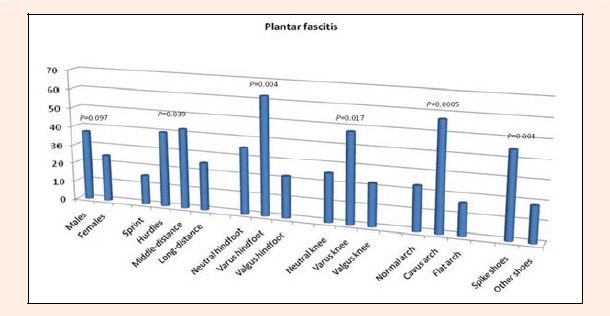
Major factors affecting the occurrence of plantar fasciitis (percentage of athletes involved by the disease in the previous five years).
Achilles tendinopathy
One or more episodes of Achilles tendinopathy were reported in 24.1% of the athletes, consisting in pain along the Achilles tendon, with eventual widening of the tendon profile, and so including Achilles tendinitis and tendinosis. The diagnosis was supplemented by ultrasound examination.
The incidence of Achilles tendinopathy was statistically related with the years of activity, with the days of practice per week, with the number of kilometers per week. No statistically significant relationships were found with the athlete’s age, gender, height, weight and BMI.
Achilles tendinopathy mostly affected competitive runners. The influence of running specialty had a tendency towards significance, with 33.3% of middle-distance runners and 21.9% of long distance runners affected, vs. 15.4% of sprinters and 0% of hurdlers affected (p = 0.057).
The incidence of Achilles tendinopathy was statistically related with the use of spike shoes (A7) (32.5% vs. 16.3% with all the other shoes; p = 0.018), and with shock-absorbing shoes (A3) (31.7% vs. 16.7% with all the other shoes; p = 0.029). The use of super-light shoes (A1) had a protective effect (0% of runners affected vs. 28.8% with all the other shoes; p = 0.061).
The incidence of Achilles tendinopathy was higher in case of varus hindfoot, and with flat arch.
No statistical relationships were found between Achilles tendinopathy and knee alignment, running surfaces, initial contact and dynamic foot alignment.
When performing a multivariate analysis only some of the variables reached statistical significance: years of activity, kilometers per week, running on athletic tracks, valgus hindfoot and flat arch.
The significant parameters and related values were listed in Table 6. Major factors affecting the occurrence of Achilles tendinopathy were represented in Figure 2.
Table 6.
Achilles tendinopathy.
| Continuous variables | Patients | Mean (±SD) | p | |
|---|---|---|---|---|
| Years of activity | Affected Non affected |
13.8 (7.2) 8.4 (6.5) |
.0005 | |
| Days of practice per week | Affected Non affected |
5.6 (1.5) 4.7 (1.5) |
.002 | |
| Km per week | Affected Non affected |
63.5 (26.9) 42.2 (24.1) |
.0005 | |
| Group variables | Group | Affected (%) | p | |
| Type of activity | Sprint Hurdles Middle distance Long distance |
15.4% 0% 33.3% 21.9%, |
.057 | |
| Level | Competitive Recreational |
29.1% 14.3% |
.037 | |
| Hindfoot | Neutral Varus Valgus |
29.4% 37.5% 17.1% |
.089 | |
| Longitudinal arch | Normal Cavus Flat |
19.6% 28.6% 50.0% |
.048 | |
| Multivariate analysis | OR | 95% C.I. | p | |
| Years of activity | 1.13 | 1.06 − 1.21 | .001 | |
| Km per week | 1.03 | 1.01 − 1.05 | .006 | |
| Athletics track (with reference to other surfaces) | 5.25 | 1.26 − 21.84 | .023 | |
| Varus hindfoot (with reference to normal hindfoot) | .87 | 0.22 − 3.41 | NS | |
| Valgus hindfoot (with reference to normal hindfoot) | .32 | 0.12 − 0.86 | .024 | |
| Cavus arch (with reference to normal arch) | 1.10 | 0.41 − 2.92 | NS | |
| Flat arch (with reference to normal arch) | 16.99 | 2.76 − 104.40 | .002 | |
Figure 2.
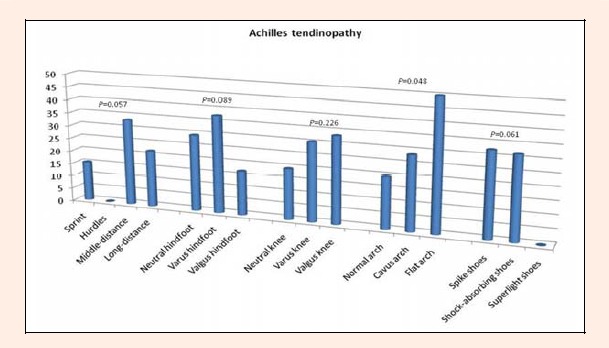
Major factors affecting the occurrence of Achilles tendinopathy (percentage of athletes involved by the disease in the previous five years).
Knee flexors injuries
One or more episodes of knee flexor injuries were reported in 14.4% of the athletes, consisting in posterior thigh pain suddenly reported during or immediately after activity. Ultrasound examination was also carried out, documenting grade II and III muscle tears. Grade I tears were not included because usually healed in less than two weeks.
The incidence of knee flexor injuries was statistically related with the years of activity, with the lower number of kilometers per week, with body weight, with height, and with BMI. No statistical relationships were found between knee flexor injuries and the athletes’ age and days of practice per week.
Males were more prone to knee flexor injuries. Running specialty had a noticeable influence, with 46.2% of sprinters and 60.0% of hurdlers affected, while 3.0% of long distance runners and 3.0% of middle-distance runners were affected (p < 0.0005). Spike shoes (A7) was significantly related with knee flexor injuries (20% vs. 9.3% with all the other shoes; p = 0.076). Knee flexor injuries were also related to midfoot running (37.5%) or initial contact with the toe (28.0%), with respect to heel initial contact (4.0%) (p < 0.005). It was related with supination, and with varus or normal knee with respect to valgus knee.
No statistical relationships were found between knee flexor injuries and sport level.
When performing a multivariate analysis only some of the variables reached statistical significance: years of activity, kilometers per week, shoe type and initial contact. The significant parameters and related values were listed in Table 7. Major factors affecting the occurrence of knee flexor injuries were represented in Figure 3.
Table 7.
Knee flexors injuries.
| Continuous variables | Patients | Mean (±SD) | p |
|---|---|---|---|
| Height (cm) | Affected Non affected |
175 (7 ) 170 (10) |
.026 |
| Weight (kg) | Affected Non affected |
66.3 (10.0 ) 58.9 (10.5 ) |
.002 |
| BMI | Affected Non affected |
21.7 (2.2) 20.4 (2.0) |
.002 |
| Years of activity | Affected Non affected |
12.4 (7.2) 9.3 (7.0) |
.026 |
| Km per week | Affected Non affected |
29.6 (13.6) 50.4 (26.8) |
<.0005 |
| Group variables | Group | Affected (%) | p |
| Gender | Males Females |
20.9% 7,5% |
.016 |
| Type of activity | Sprint Hurdles Middle distance Long distance |
46.2% 60.0% 3.0% 3.0% |
<.0005 |
| Knee alignment | Neutral Varus Valgus |
13.7% 21.7% 0% |
.08 |
| Initial contact | Heel Midfoot Toe |
4.0% 37.5% 28.0% |
<.0005 |
| Alignment | Neutral Supination Pronation |
20.0% 23.1% 0% |
<.0005 |
| Multivariate analysis | OR | 95% C.I. | p |
| Years of activity | 1.21 | 1.08 - 1.35 | .001 |
| Km per week | 0.95 | 0.92 - 0.98 | .001 |
| Shoes other than A3 (with reference to A3) | 7.18 | 1.32 - 38.40 | .022 |
| Initial contact with midfoot (with reference to heel) | 6.04 | 1.57 - 23.15 | .009 |
| Initial contact with toe (with reference to heel) | 5.21 | 0.79 - 34.37 | .086 |
Figure 3.
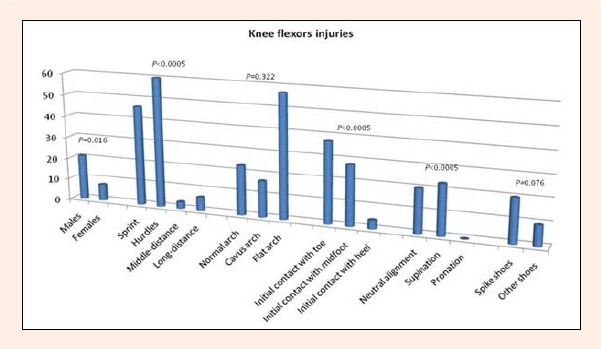
Major factors affecting the occurrence of knee flexors injuries (percentage of athletes involved by the disease in the previous five years).
Stress fractures
Stress fractures were reported in 9.6% of the athletes. They were diagnosed by standard X-rays in 9 cases. In 4 cases a developmental X-ray control was needed after 8-10 days, while in the remaining 3 cases an MRI was performed. Among the 16 stress fractures, four involved the II metatarsal (25%), four were on the fifth metatarsal (25%), four on the navicular (25%) and four on the calcaneus (25%).
The incidence of stress fractures was related with the years of activity, with the days of practice per week, with the kilometers per week, with the lower body weight, and with the lower BMI. No statistical relationships were found between stress fractures and athletes’ age and height. Stress fractures were more common in women, and competitive runners.
Running specialty had a noticeable influence, with only the middle-distance (18.2%) and the long distance runners (6.3%) being involved (p = 0.017).
Stress fractures mainly involved street runners (14.0% vs. 0% in the other running surfaces; p = 0.003), and runners who used spike shoes (A7) (17.5% vs. 2.3% with all the other shoes; p = 0.001). Stress fractures were more frequent in athletes with varus hindfoot, and with flat foot. We could not found out any statistical relationship between the site of fracture and the specific variables, but all the navicular fractures occurred in case of flat foot.
The significant parameters and related values were listed in Table 8. Major factors affecting the occurrence of stress fractures were represented in Figure 4.
Table 8.
Stress fractures.
| Continuous variables | Patients | Mean (±SD) | p | ||
|---|---|---|---|---|---|
| Weight (kg) | Affected Non affected |
54.0 (4.7) 60.6 (11.0) |
.009 | ||
| BMI | Affected Non affected |
19.4 (1.7) 20.7 (2.1) |
.011 | ||
| Years of activity | Affected Non affected |
13.6 (8.3) 9.3 (6.8) |
.034 | ||
| Days of practice per week | Affected Non affected |
7.0 (1.6) 4.7 (1.4) |
.0005 | ||
| Km per week | Affected Non affected |
84.4 (22.1) 43.4 (23.6) |
.0005 | ||
| Group variables | Group | Affected (%) | p | ||
| Gender | Males Females |
4.7% 15.0% |
.034 | ||
| Type of activity | Sprint Hurdles Middle distance Long distance |
0% 0% 18.2% 6.3% |
.017 | ||
| Level | Competitive Recreational | 14.5% 0% |
.01 | ||
| Hindfoot | Neutral Varus Valgus |
2.9% 25.0% 12.9% |
.015 | ||
| Longitudinal arch | Normal Cavus Flat |
7.1% 4.8% 50.0% |
.0005 | ||
Figure 4.
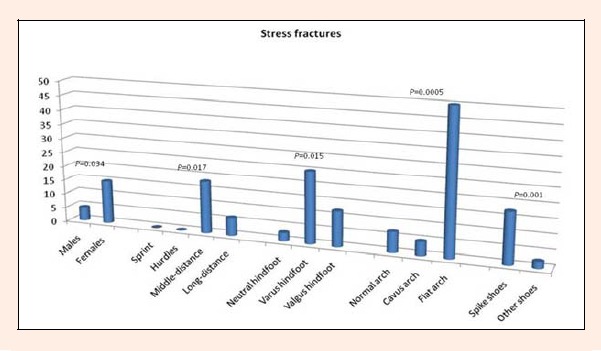
Major factors affecting the occurrence of stress fractures (percentage of athletes involved by the disease in the previous five years).
Metatarsalgia
One or more episodes of metatarsalgia were reported in 7.2% of the athletes, consisting in chronic pain on the plantar aspect of one or more metatarsal heads, with various location and etiology.
The significant parameters and related values were listed in Table 9. Major factors affecting the occurrence of metatarsalgia were represented in Figure 5.
Table 9.
Metatarsalgia.
| Continuous variables | Patients | Mean (±SD) | p | ||
|---|---|---|---|---|---|
| Years of activity | Affected Non affected |
15.3 (7.8) 9.3 (6.9) |
.008 | ||
| Days of practice per week | Affected Non affected |
6.7 (2.7) 4.8 (1.4) |
.004 | ||
| Km per week | Affected Non affected |
69.2 (43.0) 45.7 (24.0) |
.06 | ||
| Group variables | Group | Affected (%) | p | ||
| Hindfoot | Neutral Varus Valgus |
2.9% 25.0% 7.3% |
.09 | ||
| Initial contact | Heel Midfoot Toe |
10.0% 0% 12.5% |
.058 | ||
| Alignment | Neutral Supination Pronation |
6.7% 0% 14.8% |
.013 | ||
Figure 5.
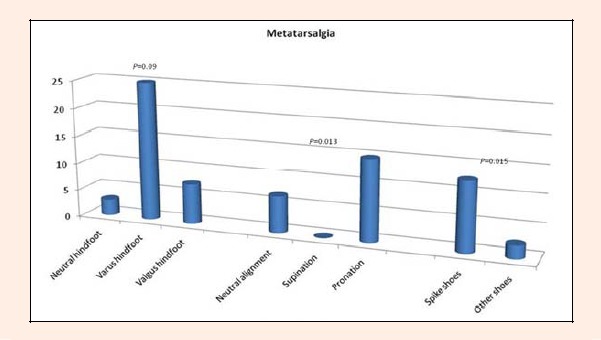
Major factors affecting the occurrence of metatarsalgia (percentage of athletes involved by the disease in the previous five years).
The incidence of this condition was related with the years of activity, with the number of kilometers per week, and with the days of practice per week. No statistical relationships were found between metatarsalgia and the athletes’ age, weight, height and BMI.
This condition mainly involve field runners (14.8% vs. 3.6% for other surfaces; p = 0.02), and runners who use spike shoes (A7) (12.5% vs. 2.3% for all the other shoes; p = 0.015). The occurrence of metatarsalgia was also related with pronation, with varus hindfoot, and with initial contact with the toe. No statistical relationships were found between metatarsalgia and the digital formula and knee alignment.
Triceps surae injuries
One or more episodes of triceps surae injuries were reported in 6.0% of the athletes, consisting in calf pain suddenly reported during or immediately after activity. Ultrasound examination was also carried out, documenting grade II and III muscle tears. Grade I tears were not included because usually healed in less than two weeks.
The incidence of this injury was related with the years of activity, with body weight, and with height. No statistical relationships were found between triceps surae injuries and the athletes’ age, days of practice and kilometers per week, and with BMI.
Males were more prone to triceps surae injuries. Hurdlers were most frequently affected (20.0%) with respect to middle- distance runners (9.1%), sprinters (7.7%) and long distance runners (0%) (p = 0.032).
The activity level had great importance, with only the competitive runners being involved. Other factors which played a role in the incidence of triceps surae injuries were the use of spike shoes (A7) (12.5% vs. 0% with all the other shoes; p = 0.005), initial contact with the toe, varus hindfoot, cavus foot, and varus knee. No statistical relationships were found between triceps surae injuries and any running surfaces.
The significant parameters and related values were listed in Table 10. Major factors affecting the occurrence of triceps surae injuries were represented in Figure 6.
Table 10.
Triceps surae injuries.
| Continuous variables | Patients | Mean (±SD) | p | ||
|---|---|---|---|---|---|
| Height (cm) | Affected Non affected |
180 (3) 170 (10) |
.0005 | ||
| Weight (kg) | Affected Non affected |
69.0 (4.3) 59.4 (10.8) |
.002 | ||
| Years of activity | Affected Non affected |
14.2 (7.4) 9.4 (7.0) |
.05 | ||
| Group variables | Group | Affected (%) | p | ||
| Gender | Males Females |
11.6% 0% |
.002 | ||
| Type of activity | Sprint Hurdles Middle distance Long distance |
7.7% 20.0% 9.1% 0% |
.032 | ||
| Level | Competitive Recreational |
9.1% 0% |
.017 | ||
| Hindfoot | Neutral Varus Valgus |
5.9% 25.0% 2.4% |
.002 | ||
| Longitudinal arch | Normal Cavus Flat |
3.6% 14.3% 0% |
.03 | ||
| Knee alignment | Neutral Varus Valgus |
2.0% 13.0% 11.1% |
.02 | ||
| Initial contact | Heel Midfoot Toe |
4.0% 4.0% 25.0% |
.004 | ||
Figure 6.
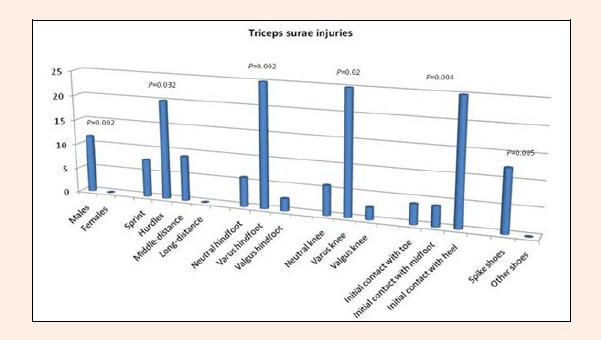
Major factors affecting the occurrence of triceps surae injuries (percentage of athletes involved by the disease in the previous five years).
Chronic anterior compartment syndrome of the leg
Chronic anterior compartment syndrome of the leg was reported in 6.0% of the athletes, consisting in persistent pain in the anterior aspect of the leg, appearing ranging from five to 30 minutes into activity. The physical examination was generally unremarkable. The diagnosis was based upon measurement of the intracompartmental pressure. The test was considered diagnostic when one or more of the following criteria were met: a pre-exercise pressure of 15mm/Hg or more; a one-minute post-exercise pressure of 30mm/Hg or more; or a five-minute post-exercise pressure of 20mm/Hg or more (Pedowitz et al., 1990). In some cases radiographs, bone scanning, CT and MRI were used as an aid in differential diagnosis, distinguishing stress fractures, periosteal reactions, tumors or lower back pathology.
We included athletes having symptoms lasting for a minimum of two weeks, limiting sport participation, even if not resulting in complete sport rest.
The incidence of this condition was related with the number of kilometers per week, with body weight, and height. No statistical relationships were found between chronic anterior compartment syndrome of the leg and athletes’ age, days of practice per week and BMI.
This condition mainly affected males (9.3% vs. 2.5% among women), middle-distance runners (9.1% vs. 6.3% among long distance runners and 0% among sprinters and hurdlers), although the two last data were not statistically significant.
The incidence of chronic anterior compartment syndrome of the leg was related with spike shoes (A7) (10.0% vs. 2.3% for all the other shoes, p=0.051), and with shock-absorbing shoes (A3) (9.8% vs. 2.4% for all the other shoes; p=0.055).
No statistical relationships were found between chronic anterior compartment syndrome of the leg and activity level, dynamic and static foot and knee alignment, and running surfaces.
The significant parameters and related values were listed in Table 11. Major factors affecting the occurrence of chronic anterior compartment syndrome of the leg were represented in Figure 7.
Table 11.
Chronic anterior compartment syndrome of the leg.
| Continuous variables | Patients | Mean (±SD) | p |
|---|---|---|---|
| Height (cm) | Affected Non affected |
177 (6) 170 (10) |
.01 |
| Weight (kg) | Affected Non affected |
64.8 (4.9) 59.7 (11.0) |
.04 |
| Km per week | Affected Non affected |
67.0 (11.4) 46.1 (26.5) |
.005 |
Figure 7.
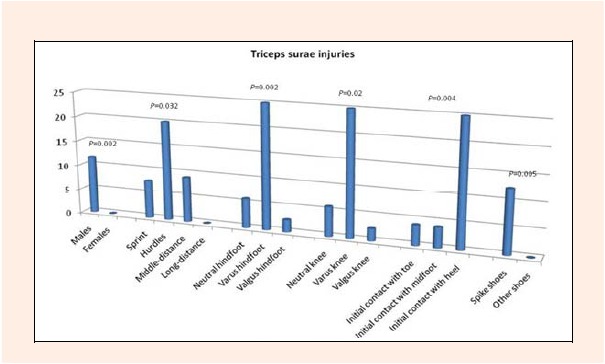
Major factors affecting the occurrence of chronic anterior compartment syndrome of the leg (percentage of athletes involved by the disease in the previous five years).
Discussion
The present study evaluated a large population of runners from the various specialties, considering all the most frequent foot and lower limb diseases, and correlating them to all the possible subjective variables, including generalities, type and conditions of sport practicing, and foot morphology examined under static and dynamic conditions. The study examined seven different diseases, trying to correlate them to a lot of variables: this generated a mathematical analysis which should be useful for future insights on specific aspects. Multivariate analysis was able to circumscribe the significant variables affecting diseases, but this kind of analysis was feasible only for the most frequent diseases. One limitation of this study was that the foot examination was only clinical and foot morphology and function was determined subjecttively by one author.
We found out a high incidence of non-traumatic disorders of the foot and lower limb among runners. Over the five years follow-up period, 59% of athletes reported one or more conditions with a minimum sport rest of two weeks. According to the literature (Barr et al., 2005), the most common diseases were plantar fasciitis (31% of athletes) and Achilles tendinopathies (24% of athletes). Overall, the more prone to injuries were males (60.9% affected), competitive runners (70.9%), middle-distance runners (51.7%), and those using spike shoes (80.3%). Age was not an important predictor of running injuries in general (Koplan et al., 1982; Macera et al., 1989), as well as body weight (Marti et al., 1988; Walter et al., 1989; Renström et al., 1993) and height (Freeman et al., 1965). Considering the morphological characteristics of the foot, the most prone to injury were the varus hindfoot (87.5%) and the cavus arch (71.4%): these two conditions are often associated in the cavus foot. The fact that cavus foot is more prone to injuries in general is not surprising, due to its less flexible structure. Considering the single diseases, the present study showed that the knee flexors tears were not related to the morphology of the foot, but mainly to general factors such as body weight and height, and the type of activity (sprinters, initial contact with the toe, use of spike shoes). Multivariate analysis pointed out that the most relevant factors were all related to short distance running, such as the lower number of kilometers per week, the non-use of shock-absorbing shoes, the initial contact with midfoot or toe. Knee flexors injuries are so related with short and intense efforts.
The injuries of the triceps surae had a different behavior, being still related to the type of activity (hurdlers, use of spike shoes), but also with the morphology of the foot, with predilection for cavus foot.
Plantar fasciitis were related to cavus foot (Simons et al., 2001), because of poor flexibility. The arched shape of the foot puts tension on the plantar fascia. Moreover, the equine forefoot leads to a forced dorsiflexion that accentuates the tension. Varus knee, which is often associated to cavus foot, was another relevant factor. Univariate analysis pointed out an increased incidence of plantar fasciitis in competitive athletes, while multivariate analysis found out that this incidence was related to the use of spike shoes in competitive athletes, so that the major affecting factor was not the level of activity, but the use of spike shoes.
Achilles tendinopathies were instead strongly associated with flat foot. This is not surprising considering the Achilles retraction that is frequently associated, due to the equine position of the calcaneus. An interesting finding was that Achilles tendinopathies were related to the use of both spike (A7) and shock-absorbing shoes (A3). The use of light shoes was instead protective against Achilles tendinopathies.
Contrary to the posterior muscular chain injuries, the anterior compartment syndromes of the leg, very common in the middle-distance runners, were not related to the morphology of the foot, nor to the running surfaces, nor to the footwear. We believe that this is because the function of the extensor muscles is minimally influenced by the foot contact to the ground: this disease is mainly related to the amount of kilometers per week, and therefore to chronic overuse.
According to the literature (Arendt et al., 2003; Epperly et al., 2001; Korpelainen et al., 2001; Lloyd et al., 1986), stress fractures were commonly related to female sex, low body weight, middle and long-distance running, running on hard surfaces or with spike shoes. Stress fractures were related both with varus hindfoot (Barr et al., 2005) and flat foot. The incidence of stress fractures in cavus foot is believed to be secondary to the more rigid, reduced shock absorbency of this type of foot (Korpelainen et al., 2001; Lloyd et al., 1986). Other investigators believe that a pes planus is more at risk because of increased pronation, and therefore, muscular fatigue, which causes increased forces to be transmitted to the bone (Epperly et al., 2001; Korpelainen et al., 2001; Simons et al., 2001). We could not found out any statistical relationship between the site of fracture and the foot morphology, but all the navicular fractures occurred in case of flat foot.
Conclusion
We consider important a deep knowledge of the factors predisposing runners to specific diseases, which are often chronic and highly debilitating for the athlete. This may allow to implement effective therapeutic measures, which may include modification of type of activity, footwear or running surfaces, correction of body weight, and orthoses to optimize the support of the foot to the ground.
Table 3.
Foot morphology and function.
| N | % | ||
|---|---|---|---|
| Longitudinal arch |
Normal Flat Cavus |
112 12 42 |
67.5 7.2 25.3 |
| Hindfoot |
Normal Valgus Varus |
68 82 16 |
41.0 49.3 9.6 |
| Digital formula |
Egyptian Greek Square |
82 60 24 |
49.4 36.1 14.4 |
|
Knee alignment |
Normal Varus Valgus |
102 46 18 |
61.4 27.7 10.8 |
| Initial contact |
Heel Toe Midfoot |
100 16 50 |
60.2 9.6 30.1 |
| Alignment |
Neutral Pronation Supination |
60 52 54 |
36.1 31.3 32.5 |
| Stride lenght |
Normal Frequent Wide |
88 28 50 |
53.0 16.9 30.1 |
| Posture |
Neutral Umbalanced backward Umbalanced forward |
50 46 70 |
30.1 27.7 42.1 |
Table 4.
Foot diseases.
| N | % | |
|---|---|---|
| Plantar fascitis | 52 | 31.3 |
| Achilles tendinopathies | 40 | 24.1 |
| Knee flexors injuries | 24 | 14.4 |
| Stress fractures | 16 | 9.6 |
| Metatarsalgia | 12 | 7.2 |
| Ileo-tibial band syndrome | 10 | 6.0 |
| Chronic anterior compartment syndrome of the leg | 10 | 6.0 |
| Triceps surae injuries | 10 | 6.0 |
Biographies
Francesco Di Caprio
Employment
Orthopaedic clinic, University of Bologna, Italy
Degree
MD
Research interests
General orthopedics, sports medicine, arthroscopy
E-mail: fra.dicaprio@gmail.com
Roberto Buda
Employment
Orthopaedic clinic, University of Bologna, Italy
Degree
MD
Research interests
General orthopedics, sports medicine, arthroscopy
E-mail: roberto.buda@ior.it
Massimiliano Mosca
Employment
Orthopaedic clinic, University of Bologna, Italy
Degree
MD
Research interests
General orthopedics, foot surgery
E-mail: massimiliano.mosca@fastwebnet.it
Antonino Calabro’
Employment
Orthopaedic clinic, University of Bologna, Italy
Degree
DPM
Research interests
Podiatry
E-mail: antoninoclbr@gmail.com
Sandro Giannini
Employment
Orthopaedic clinic, University of Bologna, Italy
Degree
MD
Research interests
General orthopedics, foot surgery, sports medicine.
E-mail: giannini@ior.it
References
- Arendt E., Agel J., Heikes C., Griffiths H.(2003) Stress injuries to bone in college athletes: a retrospective review of experience at a single institution. American Journal of Sports Medicine 31(6), 959-968 [DOI] [PubMed] [Google Scholar]
- Barr K.P., Harrast M.A.(2005) Evidence-based treatment of foot and ankle injuries in runners. Physical medicine and rehabilitation clinics of North America, 16(3), 779-799 [DOI] [PubMed] [Google Scholar]
- Birrer R.B., Buzermanis S., Della Corte M.P., Grisalfi P.J. (2001) Biomechanics of running. : Textbook of running medicine. Eds: O'Connor B.L., Wilder R.P., Nirschl R.New York: McGraw-Hill; 11-19 [Google Scholar]
- Bovens A.M., Janssen G.M., Vermeer H.G., Hoeberigs J.H., Janssen M.P., Verstappen F.T.(1989) Occurrence of running injuries in adults following a supervised training program. International Journal of Sports Medicine 10(Suppl 3), S186-190 [DOI] [PubMed] [Google Scholar]
- Cavanagh P.R., Lafortune M.A.(1980) Ground reaction forces in distance running. Journal of Biomechanics 13(5), 397-406 [DOI] [PubMed] [Google Scholar]
- Epperly T., Fields K.B.(2001) Epidemiology of running injuries. : Textbook of running medicine. : O'Connor B.L., Wilder R.P., Nirschl R.New York: McGraw-Hill; 3-9 [Google Scholar]
- Freeman M.A., Dean M.R., Hanham I.W.(1965) The etiology and prevention of functional instability of the foot. Journal of Bone and Joint Surgery [Br] 47(4), 678-685 [PubMed] [Google Scholar]
- Jacobs S.J., Berson B.L.(1986) Injuries to runners: a study of entrants to a 10, 000 meter race. American Journal of Sports Medicine 14(2), 151-155 [DOI] [PubMed] [Google Scholar]
- James S.L., Bates B.T., Osternig L.R.(1978) Injuries to runners. American Journal of Sports Medicine 6(2), 40-50 [DOI] [PubMed] [Google Scholar]
- Koplan J.P., Powell K.E., Sikes R.K., Shirley R.W., Campbell C.C.(1982) An epidemiologic study of the benefits and risks of running. JAMA 248(23), 3118-3121 [PubMed] [Google Scholar]
- Korpelainen R., Orava S., Karpakka J., Siira P, Hulkko A.(2001) Risk factors for recurrent stress fractures in athletes. American Journal of Sports Medicine 29(3), 304-310 [DOI] [PubMed] [Google Scholar]
- Lloyd T., Triantafyllou S.J., Baker E.R., Houts P.S., Whiteside J.A., Kalenak A., Stumpf P.G.(1986) Women athletes with menstrual irregularity have increased musculoskeletal injuries. Medicine and Science in Sports and Exercise 118(4), 374-379 [PubMed] [Google Scholar]
- Macera C.A., Pate R.R., Powell K.E., Jackson KL, Kendrick J.S., Craven T.E.(1989) Predicting lower-extremity injuries among habitual runners. Archives of Internal Medicine 149(11), 2565-2568 [PubMed] [Google Scholar]
- Marti B., Vader J.P., Minder C.E., Abelin T.(1988) On the epidemiology of running injuries. The 1984 Bern Grand-Prix study. American Journal of Sports Medicine 16(3), 285-294 [DOI] [PubMed] [Google Scholar]
- McKenzie D.C., Clement D.B., Taunton J.E.(1985) Running shoes, orthotics, and injuries. Sports Med 2(5), 334-347 [DOI] [PubMed] [Google Scholar]
- Pedowitz R.A., Hargens A.R., Mubarak S.J., Gershuni D.H.(1990) Modified criteria for the objective diagnosis of chronic compartment syndrome of the leg. American Journal of Sports Medicine 18(1), 35-40 [DOI] [PubMed] [Google Scholar]
- Pollock M.L., Gettman L.R., Milesis C.A., Bah M.D., Durstine L., Johnson R.B.(1977) Effects of frequency and duration of training on attrition and incidence of injury. Medicine and Science in Sports, 9(1), 31-36 [PubMed] [Google Scholar]
- Renström A.F.(1993) Mechanism, diagnosis, and treatment of running injuries. Instructional Course Lectures, 42, 225-234 [PubMed] [Google Scholar]
- Simons S.M.(2001) Foot injuries in the runner. : Textbook of running medicine. : O'Connor B.L., Wilder R.P., Nirschl R.New York: McGraw-Hill; 213-226 [Google Scholar]
- Walter S.D., Hart L.E., Mc Intosh J.M., Sutton J.R.(1989) The Ontario cohort study of running-related injuries. Archives of Internal Medicine 149(11), 2561-2564 [PubMed] [Google Scholar]
- Watson M.D., Di Martino P.P.(1987) Incidence of injuries in high school track and field athletes and its relation to performance ability. American Journal of Sports Medicine 15(3), 251-254 [DOI] [PubMed] [Google Scholar]


